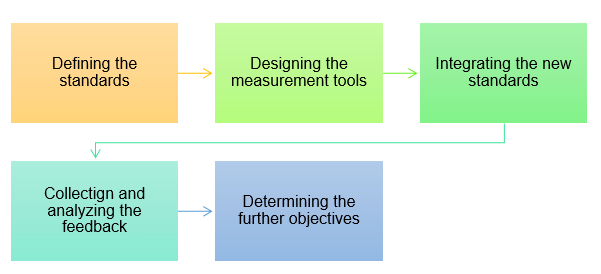Introduction: Significance of a Dress Code and Uniforms in an Educational Environment
The idea of introducing a uniform dress code in the school setting has been the subject of numerous debates. While there are several disadvantages to it (e.g., possible financial issues for parents compared to cheaper dressing options), the positive aspects seem to be more numerous. For instance, the threat of social conflict is reduced due to the homogeneity of the dressing options (Baumwirt, 2017). Furthermore, the focus will be shifted from appearance-related issues to academic progress. To promote an improvement in the students’ performance and reduce the possibility of social confrontations at the Medical Assisting Vocational School, one will have to consider affordable dress code options for male and female students.
Problem Definition: Lack of Dress Code Instructions at the Medical Assisting Vocational School
There is a consistent need to help learners to focus on the academic process and the improvement of their skills and knowledge. While social interactions are also crucial, different dressing styles contribute to conflicts and social stratification rather than efficient communication and cooperation. The introduction of uniform dressing styles will supposedly help reduce the levels of social confrontation and help the learners focus on improving their academic scores (Case, 2016).
Solution: How to Introduce New Standards at the Medical Assisting Vocational School
The development of a dress code that will compel the learners to wear trousers and shirts with collars will ostensibly trigger a drop in the number of social conflicts. The color scheme will be based on the official colors of the school. Particularly, the use of light blue, white, black, and navy should be viewed as an option. The identified color palette can be regarded as suitable for both men and women. Furthermore, the use of cotton, polyester, and wool should be considered an option due to the reasonable prices for the said materials. Thus, the introduction of the dress code rules will not face significant resistance among the students. In contrast, the use of a more expensive material may trigger dissatisfaction among lower-class learners (Baumwirt, 2017).
Change Management: What Needs to Be Accomplished to Change the Dress Code
It would be wrong to assume that a massive improvement will occur with the statement of the fact that the school will transfer to the use of rigid dress code standards. Quite on the contrary, the process of change must be gradual and profound so that the new standards should sink in more efficiently. Particularly, six crucial stages will have to be completed (Williams, 2014).
First and most obvious, the establishment of the standards in accordance with which the dress code will be altered will have to be considered. Particularly, the emphasis on equality and the reduction in the level of social tension between the learners should be viewed as priorities. Once the appropriate values and norms are introduced into the school environment, the premises for change will be built (Fossey & DeMitchell, 2014).
Afterward, the tools for measuring the success of introducing the dress code into the target environment should be considered. Two primary variables will be scrutinized in the course of the assessment, i.e., the quality of communication among the learners (i.e., the changes in the number of conflicts occurring between them) and the learners’ performance rates (i.e., the grades that they receive, the timeliness of completing their assignments, the level of proficiency that they demonstrate, etc.). The identified framework will be used as the means of monitoring the outcomes of the change in the target environment (Williams, 2014).
The integration of the said standards and the shift toward using uniform clothes in the Medical Assisting Vocational School setting will be the next step. As stressed above, it is unlikely that the learners will accept the identified innovation eagerly. Therefore, the emphasis on the new values and standards developed during the first stage of the program will become essential (Moore, 2014).
Gathering feedback from the students two or three months after the dress code is established will be crucial. The information retrieved in the process will serve as the foundation for assessing the success of the project. Coupled with the results of the students’ progress analysis, it will show whether the promotion of a new dress code has a tangible effect on the learners’ progress in their studies and the quality of communication between them (White, 2014).
Finally, the identification of the goals that will have to be completed after the new dress code has been established will be required. Claiming that the focus on uniform clothing will help improve the students’ performance and communication would be quite a stretch. Yet, the promotion of a specific dress code is bound to create prerequisites for equality in the educational setting. Therefore, the outcomes of the change will inform the further choice of management strategies (Moore, 2014) (see Fig. 1).

Conclusion: Introducing a Dress Code to the Medical Assisting Vocational School
Uniform dress code is likely to have a positive effect on the academic progress and interpersonal relationships between the students at the Medical Assisting Vocational School. Therefore, it is recommended that a set of rigid guidelines about the clothes worn by learners should be introduced into the target setting. The implementation will require significant changes in the school policies and vision, thus, compelling the learners to reconsider their value system.
References
Baumwirt, J. (2017). Granada Hills Charter High School: Staff, parent, and student satisfaction survey results. Web.
Case, J. (2016). From power struggles to conflict resolution: Transform your school’s culture today. New York, NY: Rowman & Littlefield. Web.
Fossey, R., & DeMitchell, T. A. (2014). Student dress codes and the First Amendment: Legal challenges and policy issues. New York, NY: Rowman & Littlefield. Web.
Moore, L. (2014). The high trust classroom. New York, NY: Routledge. Web.
White, C. (2014). Community education for social justice. Springer Science & Business Media. Web.
Williams, H. (2014). Only the faces change: A high school Odyssey. New York, NY: Lulu.com. Web.